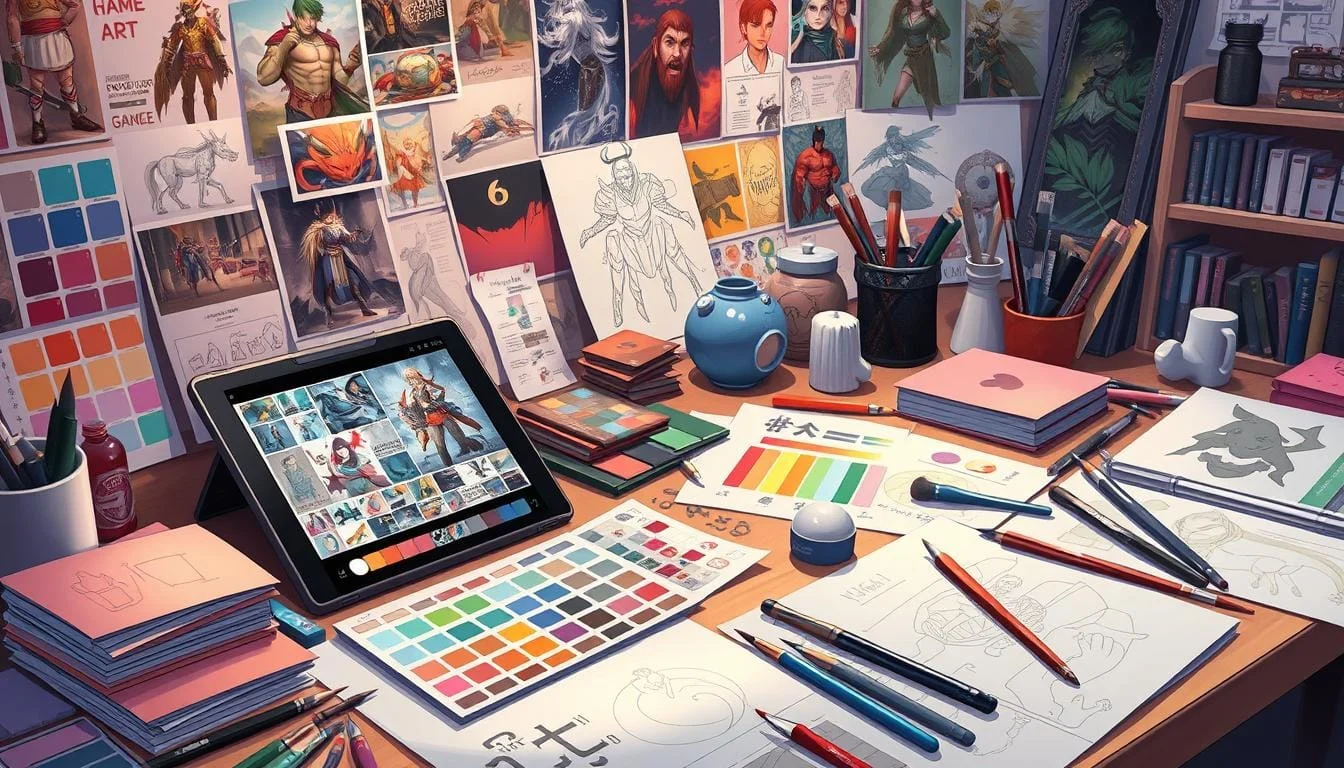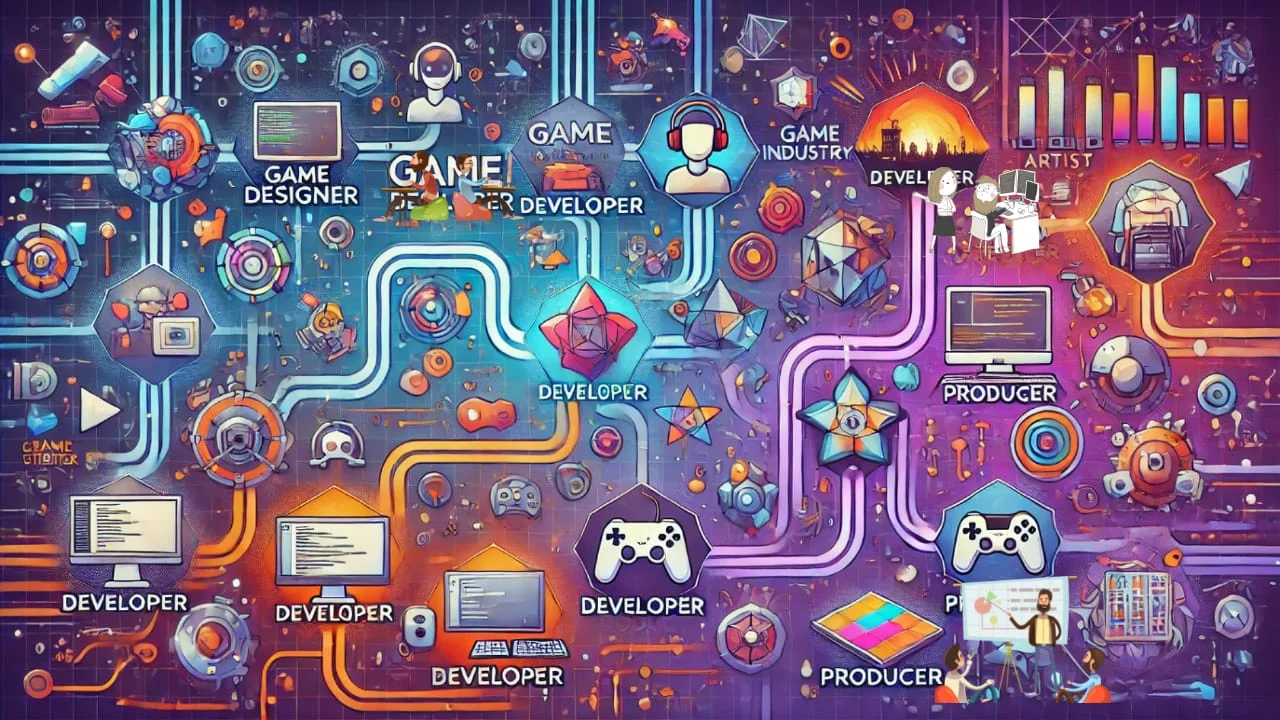Ever wondered what makes video games visually stunning and fun to play? The answer lies in game art design and game design. These two elements work together to create captivating gaming experiences.
Game art design brings virtual worlds to life. It creates characters, environments, and visual effects that transport players to new realms. Game design, however, creates the rules and mechanics that keep players engaged.

Game artists and designers team up to create amazing games. They work from initial sketches to the final product. Each role is vital in shaping the gaming experience.
Let’s explore the differences between game art and design. We’ll see how these two areas combine to create the games we love.
Want to bring your game ideas to life? Consider hiring a game art freelancer on Fiverr. Start your game development journey today!
Table of Contents
Key Takeaways
- Game art focuses on visual elements, while game design centers on mechanics and rules
- Game artists create characters, environments, and effects to bring games to life
- Game designers craft gameplay systems, level structures, and player experiences
- Both roles require unique skill sets and use specialized tools
- Collaboration between game artists and designers is crucial for successful game development
Understanding the Core Concepts of Game Development
Game development blends art and design to create captivating experiences. The gaming industry’s growth boosts demand for specialized skills. Let’s explore the key elements that bring games to life.
The Role of Visual Elements in Gaming
Visual elements define a game’s identity and atmosphere. Game artists create stunning 3D models, concept art, and user interfaces. These visuals immerse players in the game world.
Character designs and environmental assets enhance the overall gaming experience. They breathe life into the virtual worlds players explore.
The Importance of Game Mechanics
Game mechanics form the backbone of gameplay. Designers craft rules, systems, and interactions that engage players. These mechanics shape how players interact with the game world.
How Art and Design Intersect in Modern Games
In modern games, art and design work together seamlessly. Visual aesthetics complement gameplay mechanics for cohesive experiences. “Overwatch” is a great example of this harmony.
The game’s vibrant visuals enhance its core gameplay loop. This improves visual clarity and boosts player engagement.
| Game Art | Game Design |
|---|---|
| Character models | Gameplay rules |
| Environmental assets | Level layout |
| User interface | Player objectives |
| Visual effects | Game balance |
Grasping these core concepts is vital for aspiring game developers. Want to bring your game ideas to life? Consider hiring a freelance game artist or designer.
What is Game Art Design
Game art design creates visual worlds for players to explore. It brings game environments to life, from characters to scenery. Artists craft the look of games, working with designers who focus on gameplay mechanics.

Visual Asset Creation Process
Game art begins with concept sketches. Artists refine these ideas into detailed 2D artwork or 3D models. They pay close attention to color, texture, and style to match the game’s theme.
Environment artists craft immersive worlds. Character artists bring game heroes to life. Both work together to create a cohesive visual experience.
Types of Game Art Specializations
The game art field offers various specializations:
- Concept Artists: Visualize initial ideas
- Character Artists: Design and model game characters
- Environment Artists: Create game worlds and settings
- UI/UX Artists: Design game interfaces
- VFX Artists: Develop special effects
Tools and Software Used in Game Art
Game artists use powerful tools to bring their visions to reality:
- 3D Modeling: Maya, 3ds Max
- 2D Art: Adobe Photoshop, Illustrator
- Texturing: Substance Painter
- Game Engines: Unity, Unreal Engine
Mastering these tools is key for success in game art and design. The growing game industry needs skilled artists. Find talented game artists on Fiverr to bring your game vision to life.
The Essential Components of Game Design
Game design creates engaging experiences for players. It involves crafting rules, mechanics, and structures that make games fun and challenging. Let’s explore key elements game designers use to bring virtual worlds to life.
Gameplay Mechanics and Systems
Mechanics define how players interact with the game. Designers create systems for player actions, challenges, and outcomes. These mechanics shape everything from character movement to resource management.

Designers balance complexity with accessibility in game mechanics. They ensure systems are intuitive yet deep enough to maintain interest. Prototyping tools help test and refine these systems before full implementation.
Level Design Fundamentals
Level design shapes the player’s journey through the game world. Designers craft environments that challenge players and guide them through the narrative. They consider pacing, difficulty progression, and visual storytelling in their designs.
- Create engaging layouts and obstacle placement
- Balance challenge and reward
- Integrate narrative elements into level design
- Ensure smooth player flow through the environment
Player Experience and Interaction Design
How players interact with the game is crucial. Designers focus on creating intuitive controls, clear objectives, and satisfying feedback systems. They consider player agency, allowing meaningful choices that impact the game world.
| Design Element | Purpose | Example |
|---|---|---|
| User Interface | Provide information and controls | Health bars, inventory screens |
| Feedback Systems | Communicate game state to player | Sound effects, visual cues |
| Progression Systems | Motivate continued play | Level-ups, skill trees |
These components help create captivating and challenging games. Understanding these basics is key to successful game development. Want to bring your game idea to life? Find a skilled game designer to help realize your vision.
Key Skills Required for Success
The gaming industry needs a mix of creative and technical skills. Art directors and game designers must have diverse abilities. The balance between artistic vision and technical execution is crucial.

Artists must excel in visual storytelling and color theory. They need to know animation principles and industry software. Designers must master gameplay mechanics and level design. Both roles require problem-solving skills and adaptability.
Communication is vital in game development. You must express ideas clearly and work well with others. The job market for video game design is growing rapidly.
- Artistic talent and technical proficiency
- Understanding of game mechanics and systems
- Effective communication and teamwork
- Problem-solving and adaptability
- Passion for gaming and industry trends
Start your career by exploring entry-level positions like game testing. These roles offer experience and networking chances. Keep learning to stay ahead in this fast-changing industry.
Want to turn your love for games into a career? Hire a freelance game artist or designer to bring your ideas to life.
The Creative Process: From Concept to Implementation
Game development transforms ideas into immersive experiences. Creating a game world involves several crucial stages. Let’s explore how games come to life, from initial concept to final testing.
Pre-production Planning
Pre-production is the first step in building a game world. This phase typically takes up to 20% of the total production time. Concept artists sketch ideas, game designers outline mechanics, and the team develops a prototype.

Asset Development Workflow
Full production begins after concept approval. This stage can last 1 to 4 years, depending on the game’s scope. Artwork often consumes 75-90% of a game’s budget.
Artists create detailed 3D models, textures, and animations. Designers craft game levels and refine gameplay mechanics. These elements bring the game world to life.
Integration and Testing Phases
The final stretch involves integrating all elements into a cohesive game world. Developers combine art assets with game systems, ensuring smooth operation. Rigorous testing follows, with players providing feedback on prototypes.
This iterative process continues until the game meets quality standards. It’s a crucial step in delivering a polished product.
| Development Stage | Time Frame | Key Activities |
|---|---|---|
| Pre-production | Up to 20% of total time | Concept art, game design, prototyping |
| Production | 1-4 years | Asset creation, level design, programming |
| Integration and Testing | Varies | Asset integration, playtesting, refinement |
Game development is a complex and time-consuming process. Grand Theft Auto V cost $137M to make and $128M to market. The results can be impressive, like Minecraft with over 100 million monthly active players.
Bringing your game idea to life? Consider hiring skilled game developers.
Career Paths and Industry Roles
The game industry offers many career paths for artists and designers. Environmental artists craft immersive digital worlds. Character artists bring heroes and villains to life through modeling.
These roles collaborate with gameplay and level designers. Together, they create cohesive gaming experiences that captivate players.

Game development careers often start at junior positions. Professionals can advance to senior roles and leadership opportunities. The industry values specialization in areas like UI/UX design or VFX artistry.
“In the game industry, your portfolio speaks louder than words. Showcase your best work to stand out.”
Salaries in gaming vary based on experience and specialization. Here’s a breakdown of median annual salaries for different roles:
| Role | Median Salary (April 2024) |
|---|---|
| 3D Modeler | $49,000 |
| Video Game Artist | $59,000 |
| 3D Game Animator | $61,000 |
| Video Game Designer | $69,000 |
| Creative Game Director | $96,000 |
Ready to start your game development career? Find talented freelancers to work with on your next project. Gain valuable industry experience and build your portfolio.
Tools and Technologies in Modern Game Development
Game development requires a diverse set of tools. You’ll need to master various software to create stunning 3D assets. These tools are essential for bringing your game to life.
Industry-Standard Software
3ds Max excels in creating detailed 3D models and animations. Adobe Photoshop remains unbeatable for texturing and 2D art. ZBrush handles millions of polygons with ease, making it perfect for digital sculpting.

Game Engines and Development Platforms
Unity powers over 70% of mobile games and works with numerous platforms. Unreal Engine creates high-fidelity visuals for Triple-A titles. GameMaker Studio 2 offers an accessible entry point for indie developers.
Collaboration Tools and Asset Management
Effective teamwork is crucial in game development. Version control systems like Git help manage code changes. Asset management tools organize visual and audio elements.
| Tool | Primary Use | Key Feature |
|---|---|---|
| Unity | Game Engine | Cross-platform compatibility |
| 3ds Max | 3D Modeling | Advanced animation tools |
| Adobe Photoshop | 2D Art & Texturing | Powerful editing capabilities |
| ZBrush | Digital Sculpting | High-polygon modeling |
Mastering these tools requires dedication and practice. Your skills in Unity and 3ds Max will set you apart. Looking for guidance? Find skilled freelancers to help you navigate game development tools.
Collaboration Between Artists and Designers
Game creation thrives on teamwork. Creative and technical teams unite to bring games to life. Their collaboration is key in crafting engaging levels for players.
Communication Workflows
Effective communication is vital in game development. Teams use various tools to share ideas and stay connected. Regular meetings and feedback sessions keep everyone aligned.
Project Pipeline Integration
A smooth workflow is crucial for game projects. Artists and designers work closely to blend their work seamlessly. This integration helps avoid delays and maintains project momentum.
Problem-Solving Approaches
Challenges are common in game development. Artists and designers often team up to solve issues. They might optimize graphics or tweak gameplay to enhance player experience.

The game industry is expanding rapidly. In 2021, the U.S. had nearly 300,000 video game workers. Experts predict 30,000 new game design jobs over the next decade.
| Aspect | Artist Role | Designer Role |
|---|---|---|
| Visual Elements | Create graphics and models | Plan layout and aesthetics |
| Gameplay | Design character animations | Develop game mechanics |
| Level Creation | Craft environmental assets | Design level flow and challenges |
Artists and designers shape the gaming world together. Their combined efforts create captivating experiences for players. Need talented freelancers for your game project? Check out this website.
Conclusion
Game art and game design are crucial yet different parts of game development. Game art creates visually stunning worlds. Game design shapes the player’s interactive experience. Understanding their differences is key for aspiring gaming professionals.
The game art industry has grown since the ’90s. Studios now invest heavily in creating immersive visuals. Artists guide players and evoke emotions through color and contrast. Game art sets the tone for the entire gaming experience.
Game design focuses on gameplay mechanics and level design. It shapes how players interact with the game. Both fields need unique skills to create engaging games. The industry’s growth offers diverse career paths for creative professionals.
Want to bring your gaming vision to life? Find skilled game artists and designers on Fiverr. Start your game development journey today!
FAQ:
With questions and answers for the topic “Game Art vs Game Design: Understanding the Key Differences Explained”
Q: What is the main difference between game art vs game design?
A: The main difference between game art and game design lies in their focus. Game art is concerned with the visual aspects of a game, including 2D and 3D art, character design, and the overall look and feel. Game design, on the other hand, focuses on the mechanics, rules, and overall gameplay experience. While both are crucial for creating a successful video game, they involve different skill sets and responsibilities.
Q: What are the primary roles of a game designer?
A: The roles of a game designer typically include: 1. Developing game concepts and mechanics 2. Creating game design documents 3. Balancing gameplay elements 4. Collaborating with programmers and artists 5. Playtesting and iterating on game features 6. Ensuring the game is fun and engaging 7. Considering technical limitations and working within them Game designers need to have a broad understanding of various aspects of game development, including storytelling, psychology, and player motivation.
Q: What are the main responsibilities of a game artist?
A: Game artists are visual storytellers responsible for: 1. Creating 2D and 3D art assets 2. Designing characters, environments, and props 3. Developing the overall visual style and art direction 4. Collaborating with game designers to ensure art supports gameplay 5. Optimizing art for performance in game engines like Unity 6. Creating concept art and storyboards 7. Animating characters and objects Game artists work to bring the game’s world and characters to life through various artistic techniques and styles.
Q: How do game art and game design differ in their approach to storytelling?
A: Game art and game design differ in their approach to storytelling in several ways. Game artists focus on visual storytelling, using art to convey the game’s atmosphere, characters, and world. They create the visual language that helps players immerse themselves in the game’s universe. Game designers, however, focus on interactive storytelling, developing ways to present the game plot through gameplay mechanics, level design, and player choices. Both aspects work together to create a cohesive narrative experience for the player.
Q: What skills are essential for someone pursuing a career in game art?
A: Essential skills for a career in game art include: 1. Proficiency in 2D and 3D art software 2. Strong understanding of color theory and composition 3. Knowledge of anatomy and character design 4. Familiarity with game engines and their limitations 5. Ability to work within technical constraints 6. Collaborative skills for working with designers and programmers 7. Adaptability to different art styles and genres Additionally, game artists should have a portfolio showcasing their best work and be prepared to continuously learn new techniques and tools.
Q: How does the process of creating game art differ from general art?
A: The process of creating game art differs from general art in several ways: 1. Game art must consider technical limitations and performance optimization 2. It often requires collaboration with designers and programmers 3. Game artists need to create assets that can be animated or interacted with 4. The art must support gameplay mechanics and enhance the player experience 5. Game art often needs to be modular and reusable within the game world 6. It requires knowledge of game engines and how art is implemented in games 7. Game art must maintain consistency across various in-game scenarios and viewpoints While general art may focus solely on aesthetics, game art must balance visual appeal with functionality and performance.
Q: What are some key considerations when designing art for a fantasy game?
A: When designing art for a fantasy game, key considerations include: 1. Establishing a unique and cohesive visual style 2. Creating believable yet fantastical characters and creatures 3. Designing environments that support the game’s lore and atmosphere 4. Balancing realism with imaginative elements 5. Ensuring the art style complements the gameplay and target audience 6. Considering cultural influences and avoiding stereotypes 7. Developing a color palette that enhances the fantasy mood 8. Creating iconic and memorable designs for key characters and locations A professional game artist working on a fantasy game must blend creativity with practicality to bring the imaginary world to life while supporting the game’s design and technical requirements.
Source Links
- Game Art & Game Design: What’s the Difference?
- Discover the game design are two magical worlds of creativity
- Unlock the secrets of video game art and master creating and implementing levels
- Game Design vs. Game Development: Understanding the difference
- Dive deep into the technical limitations of the assigned platforms and learn how professionals game correctly
- What’s the difference between Game Art vs Game Design? – RMCAD
- The Difference Between Game Design and Game Art – Pixune
- Explore how a game designer is often challenged by the intricate feel of a game
- Learn how games are created by the game experts and understand the art development process
- Uncover what makes a game artist may transform virtual worlds
- Uncover the fascinating number of game design principles that make interactive experiences come alive
- Dive into professional game art courses that unlock the secrets of digital storytelling
- Uncover the mysterious difference between the two game design realms
- Master the art of game feel that transforms player experiences
- What Is a Video Game Designer? | Skills and Career Paths
- Game Design Careers | BestColleges
- 10 Best Game Design Tools in 2024 – Access Creative
- The Intersection of Game Art and Narrative Design – RMCAD
- The game designer as artist
- Game Art Design: 12 Principles That You Should Know
- All You Need to Know about Minimalist Game Art
- Concept Art for Video Games: A Complete Guide – Stepico
Related Articles:
- Understanding the Goal of Industrial Product Design in Modern Design
- Twitch Stream Overlays & Graphics Templates: Elevate Your Streaming Game
- Guide to 3D Character Modeling: Create Your Character Model from Scratch
- Custom Trade Show Booth Design & Displays | Innovative Booth Solutions
- How Much Does a Gaming Trailer Cost? Video Game Trailer Cost Ultimate Guide
Our Partners: CSKDesignCrafts.com – FitFusioHub.com – LifeCraftsCentre.com
This post contains affiliate links, which means I may earn a commission if you make a purchase through these links. There is no additional charge to you! Thank you for supporting my blog so I can continue creating free content each week!




